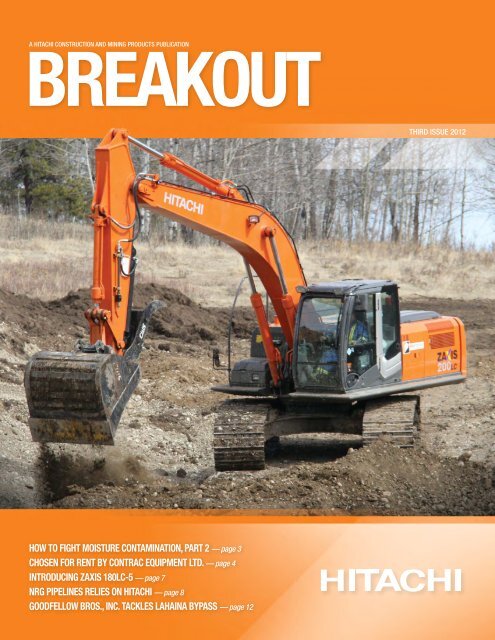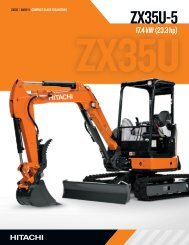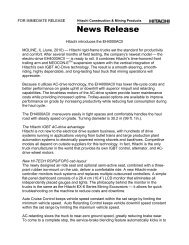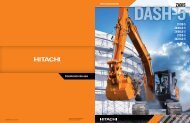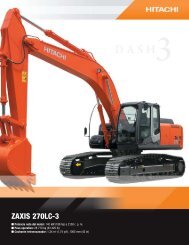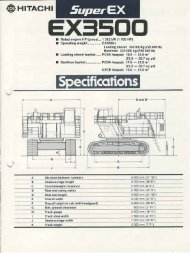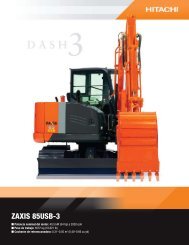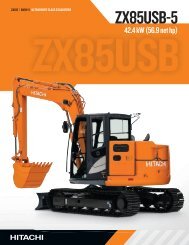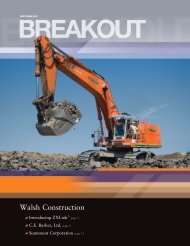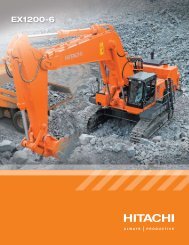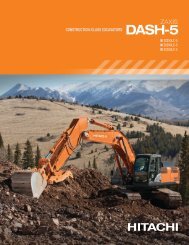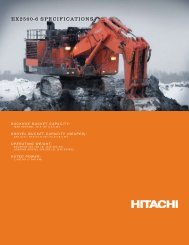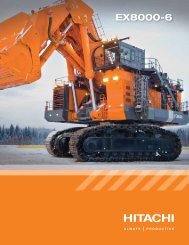Issue 3 - Hitachi
Issue 3 - Hitachi
Issue 3 - Hitachi
Create successful ePaper yourself
Turn your PDF publications into a flip-book with our unique Google optimized e-Paper software.
A HITACHI CONSTRUCTION AND MINING PRODUCTS PUBLICATION<br />
breakout<br />
THIRD ISSUE 2012<br />
How to figHt Moisture ContaMination, Part 2 — page 3<br />
CHosen for rent by ContraC equiPMent ltd. — page 4<br />
introduCing Zaxis 180lC-5 — page 7<br />
nrg PiPelines relies on HitaCHi — page 8<br />
goodfellow bros., inC. taCkles laHaina byPass — page 12
ON<br />
the<br />
INSIDE<br />
What is your equipment telling you<br />
Telematics systems are being increasingly utilized in<br />
equipment management, remotely connecting maintenance<br />
managers to their machines in the field.<br />
When a machine is equipped with telematics technology,<br />
like <strong>Hitachi</strong>’s own ZXLink , real-time data<br />
is collected from the machine via a communications<br />
controller and sent wirelessly to a data server, where<br />
it is populated for viewing online. Data can also be<br />
delivered as a text message or email alert. This data<br />
includes the “vital signs” of the equipment — its location,<br />
engine hours, idle time, and other maintenancerelated<br />
stats like fluid levels, pressures, temperatures,<br />
and maintenance intervals.<br />
Having this information at hand can help you<br />
assess the health of the machine as well as document<br />
its productivity levels. When cross-referenced with<br />
fluid analysis and machine inspection reports, this<br />
data can help you make informed, cost-effective<br />
decisions regarding equipment maintenance.<br />
Systems also allow the dealer to access equipment<br />
data. In many instances, a dealer can diagnose a maintenance<br />
issue or update machine software remotely<br />
without a trip to the jobsite.<br />
Regardless of your fleet size, monitoring telematics<br />
data can make a significant improvement in machine<br />
uptime. Most new machines come equipped with a<br />
telematics system, but this technology can also be<br />
installed on older models and on all-makes fleets.<br />
Ask your <strong>Hitachi</strong> dealer about our ZXLink Select<br />
and ZXLink Ultimate equipment-management<br />
systems and how they can work for you.<br />
POWERED BY THEIR<br />
<strong>Hitachi</strong> Dash-5 are powered by the fuelefficient<br />
Interim Tier 4-certified engines,<br />
the new Dash-5s are more productive than<br />
ever. Operators will also like them for their<br />
wider cabs with improved visibility.<br />
See your <strong>Hitachi</strong> dealer today about the<br />
exciting new crop of Dash-5 excavators.<br />
www.hitachiconstruction.com<br />
Kelly Granatier, Director, Sales, <strong>Hitachi</strong> Division
InBRIEF<br />
Questions<br />
from the field:<br />
What’s the difference<br />
between passive and<br />
active exhaust-filter<br />
regeneration in <strong>Hitachi</strong><br />
Dash-5 Excavators<br />
Passive regeneration is a natural cleaning<br />
process where engine exhaust temperatures<br />
are sufficient to oxidize the particulate<br />
matter (PM) trapped in the exhaust<br />
filter. The process is continuous during<br />
normal engine operating conditions, and<br />
is the most fuel-efficient way to clean.<br />
But, if conditions (temperature, load, or<br />
speed) for passive regeneration cannot<br />
be achieved, then PM must be removed<br />
using active regeneration, an automatic<br />
cleaning process. This requires injecting<br />
a small quantity of fuel into the exhaust<br />
stream for a short duration and elevating<br />
exhaust temperatures to clean the<br />
filter. The actual cleaning process takes<br />
approximately 20 to 30 minutes. In most<br />
applications, active regeneration cleaning<br />
occurs only when passive regeneration<br />
isn’t possible based on conditions — it<br />
serves as a backup system.<br />
Remember, in most cases, the regeneration<br />
process uses exhaust heat created<br />
under normal engine operating conditions,<br />
so the operator won’t even notice<br />
it’s taking place. In the event that an<br />
active regeneration is necessary, the<br />
engine’s control system can raise exhaust<br />
temperature to regenerate the filter. With<br />
either method, in most cases, regeneration<br />
does not impact machine operation or<br />
require operator involvement.<br />
Most of the processes with Isuzu’s Interim<br />
Tier 4 (IT4) engines happen behind the<br />
scenes, which enable operators to use<br />
their equipment the same way they used<br />
earlier <strong>Hitachi</strong> excavators powered by<br />
Isuzu engines. The diesel particulate filter<br />
is replaced at a minimum of 4,500 hours<br />
by a <strong>Hitachi</strong> dealer.<br />
For a more complete overview, read<br />
the full tech tip in the first 2012 issue<br />
of Breakout.<br />
HITACHI TECH TIPS<br />
How to fight moisture<br />
contamination Part 2<br />
In the second 2012 issue of Breakout, we looked at<br />
how moisture contamination can get into lubricating<br />
oils and your hydraulic system.<br />
Now let’s look at a way to combat it — desiccant breather filters.<br />
Finding the right breather will help the systems in your equipment last longer<br />
and prevent unnecessary downtime and oil replacement. Desiccant breathers<br />
are especially useful in environments that contain high dust and humidity levels.<br />
Desiccant breathers are comprised of a silica gel that attracts and retains up to 40<br />
percent of its weight in water. Together with a synthetic filter media, they prevent<br />
moisture and particle contamination from getting into your reservoirs as pressure<br />
fluctuations occur through thermal expansion and contraction of the fluid and the<br />
level changes produced by the filling and emptying of the reservoirs. When carbon<br />
is added to the silica gel, the breathers can capture oil mist and evenly disperse<br />
incoming air so that the synthetic filter and silica gel combination works more<br />
effectively. The more the air passes through both, the cleaner<br />
it becomes. If a breather is designed with more vent holes to<br />
allow variable airflow patterns, it increases the filtration media<br />
and desiccant drying capabilities.<br />
Talk to your <strong>Hitachi</strong> dealer to learn more about desiccant<br />
breather filters and how they can help you fight moisture.<br />
Some things to keep in mind when selecting desiccant breathers:<br />
n When choosing a desiccant breather size, be sure to consider the amount of air exchanged (cubic<br />
ft./min.) for each application. Airflow capacity must match or surpass the tank’s fill and drawdown<br />
rate. Breather size should increase as the flow rates increase.<br />
n Choose a steel or plastic breather housing, depending on your operating environment. Steel is a<br />
better choice if you’re dealing with hot, dusty environments.<br />
n Pay attention to the color of the silica gel as an indicator of when to change breathers, as most breather<br />
manufacturers put dyes in the silica gel to facilitate a color change when the gel becomes saturated.<br />
n If you operate in a damp and dirty environment with minimal air-volume changes, newer expansion-type<br />
breathers can better control the breathing action and permit expansion and contraction of the airspace.<br />
n Consider more specific applications for desiccant breather filters than mobile hydraulic systems, such<br />
as switch gears, gearboxes, turbines, feed pumps, oil-cooled transformers, and diesel-fuel storage tanks.<br />
3
Chosen for rent by<br />
ConTrac<br />
W<br />
Equipment Ltd.<br />
ConTrac, as one of Alberta’s largest independent rental and sales<br />
companies, offers <strong>Hitachi</strong> excavators. Shown are some of their<br />
new Dash-5 models.<br />
“<br />
e<br />
are one of the largest independent rental and<br />
sales equipment suppliers in Alberta,” says<br />
Michael Karczmarczyk, President, ConTrac. “We find<br />
equipment with the strongest market acceptance and<br />
buy the best examples available in the market for use by<br />
contractors. In many respects, we are the best testimony<br />
to just how strong a particular brand is.”<br />
Currently the company supplies Cat dozers, <strong>Hitachi</strong><br />
excavators, Volvo articulated trucks, and so on down the<br />
line. All top brands. The machines are typically rented<br />
to temporarily bolster a customer’s existing fleet, but at<br />
the same time, all pieces of equipment are for sale. And<br />
actually, after they have been rented for a predetermined<br />
number of hours, they are actively put up for sale as<br />
used. All machines are aggressively maintained during<br />
rental, making them good buys for ConTrac’s customers.<br />
“The OEM’s have large rental fleets, of course, and<br />
there are certain equipment dealers who are also into<br />
the rental of construction equipment,” notes Darren<br />
Cels, Vice President, Sales and Rentals. “But what makes<br />
us unique is our independence — and our interest in<br />
selling. We’re not interested in buying the cheapest<br />
brand. And we’re not interested being a single-brand<br />
source. We’re okay buying new…<br />
“We supply the top brands”<br />
“...but again, our mission is to supply active, aggressive<br />
contractors with the top brands they would either<br />
like to own or already have — and just need additional<br />
numbers to serve their customers’ needs for a particular<br />
project.”<br />
ConTrac offers a diverse fleet of over 100 pieces<br />
of equipment to rent or buy, allowing them to serve<br />
customers in many different industries. The majority of<br />
their fleet consists of D6 to D8 dozers, ZX200 to ZX470<br />
<strong>Hitachi</strong> excavators, 30- and 40-tonne articulated rock<br />
trucks, and three- to four-yard wheel loaders.<br />
5
Cathy Stein, Steph George, Shaun Malmo, Jany Paquette, John Karczmarczyk, Alex Ginda, Michael Karczmarczyk, Rob Serson, Darren Cels, Gord Krysa,<br />
and Chris Halwa with Chris Mitchell, Wajax Equipment.<br />
“Our focus is on serving and growing<br />
only this middle market of heavy equipment,”<br />
says Karczmarczyk. “We are not<br />
participating in the large mining-equipment<br />
segment. Our niche market is<br />
providing excellent service and the best<br />
brands to both market-leading contractors<br />
and smaller start-ups.”<br />
What a top brand means<br />
“I think it’s important to understand<br />
how crucial it is to be tied to a<br />
market-leading piece of equipment,”<br />
says Shaun Malmo, Vice President,<br />
Finance and Operations.<br />
In Western Canada, the market<br />
acceptance of the <strong>Hitachi</strong> excavator<br />
is excellent. Contractors know and<br />
respect the productivity they’re going<br />
to get.<br />
“With new Tier 4 engine requirements,<br />
there was concern among our<br />
customers that downtime and maintenance<br />
would increase,” continues<br />
Malmo. “We really counted on <strong>Hitachi</strong><br />
bringing a finished product to market.<br />
And so far, our experience with this<br />
newest Dash-5 group of hoes we’ve<br />
recently bought has proven that, yes,<br />
<strong>Hitachi</strong> does have its act together. The<br />
benefit from our customer’s perspective<br />
is that, as a contractor, when you show<br />
up on the job with a market-leading<br />
machine, totally government compliant,<br />
100-percent ready in like-new condition,<br />
it creates a very good impression.<br />
It’s as simple as that.<br />
“And, you know,” Karczmarczyk<br />
jumps in, “for us, going with top<br />
brands also means preservation of our<br />
equity. Similar to a good stock pick,<br />
choosing the right brand and piece of<br />
equipment gives us the best bet on the<br />
final outcome of our purchase after<br />
we’ve rented it, in how we might be<br />
able to retail it.<br />
“Our experience in going with the<br />
top brands has also meant we’ve had<br />
less repair expense because the uptime<br />
is better. Looking at that on the simple<br />
side, I guess that’s an obvious but<br />
often missed statement. On the more<br />
sophisticated side, one can say that<br />
buying a top brand like <strong>Hitachi</strong> for<br />
excavators minimizes our exposure<br />
to downside risk.”<br />
Malmo adds, “There are two more<br />
things we like about <strong>Hitachi</strong> and our<br />
<strong>Hitachi</strong> dealer, Wajax Equipment. First,<br />
we aggressively use ZXLink to keep<br />
tabs on the equipment hours, maintenance<br />
schedule, and any fault codes<br />
that may arise. Our service manager<br />
finds it is the easiest to use of all similar<br />
programs, and has had instances where<br />
replacement parts were delivered before<br />
the customer knew there was an issue.<br />
Second, we buy more than just excavator<br />
parts from Wajax, and we’re very<br />
impressed with the level of service from<br />
Shop Foreman Trevor Graham — he<br />
provides us with a wealth of <strong>Hitachi</strong><br />
knowledge.”<br />
For ConTrac, their number-one goal<br />
is to convince a prospective customer<br />
they should rent or buy from them. So<br />
that’s why, to help make their case, they<br />
carefully purchase the most popular<br />
brands at the very best price. And then,<br />
as the months go by on a rental, or<br />
especially when the piece comes back,<br />
ConTrac goes beyond the norm to fix<br />
and replace all possible damaged parts<br />
so that when it leaves again either on<br />
rental or to a permanent home, it is as<br />
first class as possible. And if it’s sold,<br />
because of the high market acceptance<br />
of <strong>Hitachi</strong>, the resale value is very<br />
good, indeed.<br />
ConTrac Equipment Ltd. is serviced by<br />
Wajax Equipment, Edmonton, Alberta.<br />
6
<strong>Hitachi</strong> introduces a new<br />
model to North America:<br />
the ZAXIS 180LC-5<br />
what happens when you specialize<br />
in excavators You build<br />
them better. You make them more reliable<br />
and productive. And you invent a<br />
model like the ZX180LC-5. New to the<br />
North American market, it is specifically<br />
designed to appeal to small local<br />
contractors, water and sewer contractors,<br />
and those who dig basements and<br />
pools. It packs excellent productivity<br />
and fuel economy into a small package.<br />
The ZX180LC-5 is slightly bigger<br />
than the new 160LC-5, yet has a<br />
unique boom/arm configuration for<br />
greater lift capacity and a wider undercarriage<br />
for more stability. It is lighter<br />
and easier to transport than the nextsized<br />
up 210-5/210LC-5 Excavators,<br />
yet can perform much of the same<br />
work while saving diesel-fuel dollars.<br />
Machine specifics<br />
The ZX180LC-5 comes equipped<br />
with either a 2.71-m (8-ft. 10-in.) or<br />
3.21-m (10-ft. 6-in.) arm, and 600-,<br />
700-, or 800-mm (24-, 28-, or 32-in.)<br />
triple semi-grouser shoes. The powerful<br />
IT4 Isuzu AI-4JJ1 diesel engine generates<br />
90 kW (121 hp). Special features<br />
such as a heated air-suspension seat,<br />
additional lighting, and a rearview<br />
camera are optional. Need even more<br />
Among other options are a controlpattern<br />
change valve, varying bucket<br />
sizes, and high-flow auxiliary hydraulic<br />
packages.<br />
Three work modes allow an operator<br />
to choose a digging style that fits<br />
the job. High Productivity (HP) delivers<br />
more power and faster hydraulic<br />
response. Power (P) delivers a balance<br />
of power, speed, and fuel economy for<br />
normal operation. And Economy (E)<br />
maximizes fuel efficiency while delivering<br />
an enhanced level of productivity.<br />
RooMy cab with a view<br />
The spacious cab features narrow<br />
front posts, a wider door with more<br />
glass, large overhead glass, and numerous<br />
mirrors — including one on the<br />
counterweight — for excellent allaround<br />
visibility. Inside there is more<br />
side-to-side footroom, a more comfortable<br />
high-back seat with increased slide<br />
range, and an easy-to-read and easyto-operate<br />
LCD multifunction multilanguage<br />
monitor. Among other things,<br />
the monitor tracks scheduled maintenance<br />
and reminders. It even provides<br />
diagnostic codes to assist in troubleshooting,<br />
and includes an attachment<br />
support system with 11 modes to help<br />
fit different attachments.<br />
DuRability<br />
Tungsten-carbide-coated wear surfaces<br />
protect the all-important bucketto-arm<br />
joint. Reinforced resin thrust<br />
plates, grooved bushings, and thermalcoated<br />
bucket joints increase arm- and<br />
boom-lube intervals to 500 hours.<br />
Oil-impregnated HN bushings enhance<br />
durability and extend grease intervals<br />
to 500 hours for the arm and boom<br />
joint and 100 hours for the bucket<br />
joint. Reinforced D-channel side frames<br />
provide maximum cab and component<br />
protection.<br />
ZXlink ultiMate — stanDaRD<br />
The new <strong>Hitachi</strong> ZX180LC-5 comes<br />
standard-equipped with three years<br />
of ZXLink Ultimate, enabling 24/7<br />
online access to machine location,<br />
health, utilization, fuel consumption,<br />
and other valuable information for<br />
better understanding of costs and<br />
jobsite performance.<br />
For more information visit your<br />
local <strong>Hitachi</strong> dealer or go online to<br />
www.hitachiconstruction.com<br />
7
NRG Pipelines<br />
relies on <strong>Hitachi</strong> for<br />
for best production<br />
“we’re at the site of a fairly typical<br />
project for us,” says Troy<br />
Thompson, Senior Vice President,<br />
Services Group, NRG Pipelines Ltd.<br />
“We’re digging trench and installing<br />
1550 meters (5,085 ft.) of double-flex<br />
pipe for one of our customers near<br />
Garrington, Alberta. We’ve brought in<br />
three <strong>Hitachi</strong> excavators for the job —<br />
a ZX200LC-3 and two ZX250LC-5<br />
machines, plus dozers and support<br />
equipment. We’ve been here five days,<br />
and we’ll be finished in another day or<br />
two. The pipelines tie together multiple<br />
oil wells to a valve station where the<br />
oil flow is controlled for feeding into a<br />
larger collector pipe with a valve package<br />
that we’ve built.<br />
“Although a lot of flex pipe is used in<br />
Alberta, we’re also placing quite a bit<br />
of midbore pipeline from two inch to<br />
12 inch. And, we’re actively involved<br />
in specialty work as well. For example,<br />
we just finished the first install of<br />
a new, high-temp insulated pipe in<br />
Canada. We’ve place 22 kilometers<br />
(13.7 mi.) near Swan Hill in 31 days —<br />
that was a very good project.”<br />
New, with years of experieNce<br />
The company came together as a<br />
new effort about 12 months ago. And,<br />
8
in March 2012 they surpassed 100 employees.<br />
They’ve had the opportunity to<br />
bid and win some rather large fabrication<br />
work for the Swan Hills area, so<br />
they established a 1626-m 2 (17,500<br />
square feet) shop in White Court. And<br />
much of their larger projects are in<br />
far northern Alberta. But, the division<br />
established in the Red Deer area will<br />
grow too, leaving more tie-in and flex<br />
pipe work.<br />
“This last month we’ve breached<br />
into Saskatchewan with a new project<br />
that we’re kicking off next week,” says<br />
Thompson. “We’ve accomplished a lot<br />
in a small amount of time.”<br />
Although the company is new, the<br />
team is far from new to the work, and<br />
has many references and industry ties.<br />
Thompson has worked for multiple<br />
contractors during the past 17 years,<br />
starting as a pipefitter, and working up<br />
the ladder to welder, operator, supervisor,<br />
and then project manager for both<br />
contractors and oil companies.<br />
Terry Regenwetter, Senior Vice<br />
President, Corporate Services, is a<br />
mechanical engineer and has worked<br />
since graduation as a design engineer<br />
within the petroleum industry of<br />
Alberta. Additionally, he has been<br />
involved in real-estate development<br />
and construction management, with<br />
increasing experience in business<br />
management and finance.<br />
Mike Runcer’s skills parallel Thompson’s:<br />
hands-on work since he was 19,<br />
working his way up from laborer to<br />
operator to superintendent to project<br />
management. He is senior vice president,<br />
Projects Group. “We’ve learned<br />
how to complement each other, and<br />
we’re both driven to succeed.<br />
“I know we’re going to make a success<br />
of this company,” asserts Thompson.<br />
“Too many guys start a business<br />
like what we’re doing here as oil and<br />
gas booms, along with the dream of<br />
becoming rich. Well, everyone who is<br />
okay with really working would love<br />
to be rich.”<br />
But, too many guys don’t have their<br />
heart in the business. They’re not really<br />
willing to walk the walk.<br />
“The oil patch requires all out effort.<br />
It’s a 24/7 type of business. I think<br />
we’ve proven that we have the heart.<br />
I know that our customers believe we<br />
do; they wouldn’t have trusted us with<br />
their business so quickly if they didn’t.<br />
So now we’re walking the walk, and<br />
rising to the everyday effort of simply<br />
getting the job done like we said we<br />
“The <strong>Hitachi</strong> excavator is<br />
our first choice because of<br />
its rugged dependability.”<br />
— Troy Thompson,<br />
Senior Vice President<br />
9
“I’ve spent my life in the oil patch; growing up in it and working<br />
for multiple contractors from high school on. And now, using all<br />
of our resources, Mike, Terry, and I are embarked on building<br />
the best pipeline-services company we can.”<br />
— Troy Thompson, Senior Vice President<br />
would. We know what it takes, and we<br />
know what it should cost to be fair to<br />
everyone. Our closest friends are in this<br />
industry, and many of them are now<br />
working here. We’re almost family.”<br />
Why hitachi and Wajax<br />
“There are multiple reasons why<br />
we went with <strong>Hitachi</strong> excavators and<br />
Wajax Equpment, Canada’s <strong>Hitachi</strong><br />
dealer,” continues Thompson.<br />
“First, in Alberta the <strong>Hitachi</strong> hoe is<br />
an industry standard. When you look<br />
around at the big guys in our business<br />
who continue to be successful — they<br />
all have <strong>Hitachi</strong>. The company where<br />
I used to work and manage projects<br />
was 100-percent <strong>Hitachi</strong>, and we were<br />
continually impressed with how well<br />
they worked.<br />
10
“I know as it relates to this article<br />
that we’re one of the first to really<br />
experience the newest Dash-5 <strong>Hitachi</strong><br />
models using newest engine modifications<br />
to meet the increased pollution<br />
controls. So, here’s what we have experienced:<br />
The new Isuzu engine works<br />
better than the one in the Dash-3<br />
Series. It has worked good from the<br />
start, with more power and better fuel<br />
economy. So, no big deal on worrying<br />
about the newest engines as far as we’re<br />
concerned.<br />
“As a start-up company, we were<br />
relieved to learn how aggressive Wajax<br />
Equipment was in for pursuing our<br />
business. They have worked with<br />
us from the word ‘go’ in getting us<br />
the equipment we needed, when we<br />
needed it. And, they have helped us<br />
with suitable financing. We wanted to<br />
be exclusive — one brand and all new<br />
— because that sets the image. We’re<br />
going to be on a 5,000-hour rotation so<br />
our equipment is always current; every<br />
three years, we’ll be new. We want to be<br />
first class, not showboaters, but solid.<br />
NRG Pipelines continues to be impressed with how well the <strong>Hitachi</strong>’s work.<br />
“I already knew how strong Wajax<br />
product support was from my past<br />
dealings with them. Now, I’ve had the<br />
opportunity to learn the full extent<br />
of their business approach to making<br />
things happen. Our first order was for<br />
six hoes, and we’ve continued to add.<br />
We’re now at 13. It is hard to get good<br />
construction equipment in Alberta<br />
right now. Too often, there are plenty<br />
of delays and broken promises. But the<br />
Wajax group hasn’t let us down. And<br />
that’s what I learned before we struck<br />
out on our own.<br />
“We are determined to be a 30-hoe<br />
company successfully working in the<br />
Western Canadian oil patch,” says<br />
Thompson.<br />
“To get there,” say the three partners,<br />
“we know that we’ll have to truly<br />
keep heart, do what’s got to be done,<br />
and operate both productively and<br />
efficiently so our customers are both<br />
proud of what we do for them and<br />
happy enough to see the bill.”<br />
NRG Pipelines is serviced by Wajax<br />
Equipment, Red Deer, Alberta.<br />
NRG Pipelines is a certified fabricator of<br />
custom pressure vessels, separator packages,<br />
line heaters, and choke manifolds.<br />
11
Goodfellow Bros., Inc.<br />
tackles the<br />
Lahaina Bypass<br />
lahaina, located on the northwest<br />
coast of Maui, was once a busy<br />
whaling port and the capital of the<br />
Kingdom of Hawaii. Today, tourism<br />
reigns as king, with the town’s population<br />
swelling nearly 400 percent<br />
during peak seasons. Such an influx<br />
of people puts quite a strain on the<br />
arterial roadways, and even off season,<br />
traffic can snarl.<br />
The need for a bypass around<br />
Lahaina was identified over 30 years<br />
ago, and ever since then residents had<br />
been anxiously awaiting the highway<br />
to be authorized and the planning<br />
hurdles resolved. As most major highways<br />
in northern Maui hug the coastline<br />
on one side and are hemmed in<br />
by buildings or natural barriers on the<br />
other side, existing roads cannot easily<br />
be widened. So it was decided to build<br />
the Bypass further inland, closer to the<br />
central volcanic-formed mountains<br />
and their water-carved gulches. This<br />
ensured plenty of construction space,<br />
but meant dealing with less-thanfriendly<br />
terrain.<br />
In 2008, construction finally got<br />
underway. Five phases were established,<br />
with Goodfellow Bros., Inc. (GBI) currently<br />
tackling the complex Phase 1B-1<br />
— a 2.81-km (1.745-mi.) stretch complete<br />
with a 30.5-m (100-ft.) bridge,<br />
T-intersection, paved shoulders, traffic<br />
signal, and an agricultural-equipmentcrossing<br />
tunnel.<br />
“We’ve worked in Hawaii for 40<br />
years building roads, bridges, subdivisions,<br />
shopping centers, golf courses,<br />
and hotels on all the inhabited islands,”<br />
says Ray Skelton, Director of Business<br />
Operations — Maui, Kauai, and<br />
Molokai. “We’re excited to be a part<br />
of a long-overdue project, especially<br />
as many of us live right in the area.”<br />
Inland challenges<br />
As the Bypass is being built inland,<br />
away from heavily populated areas,<br />
one would think blasting would be the<br />
best way to remove the extremely hard<br />
volcanic basalt rock. But this project<br />
did not allow for drilling and blasting<br />
in the specifications. Instead, it called<br />
for all material to be removed by an alternate<br />
means. GBI chose to rely on its<br />
<strong>Hitachi</strong> excavators to get the job done.<br />
“Our Hawaiian basalt rock is known<br />
for being very hard and difficult to<br />
extract,” explains Bo McKuin, Project<br />
Manager. “We pride ourselves on our<br />
ability to rip basalt rock — it is one of<br />
our specialties. For this project, we used<br />
up to four <strong>Hitachi</strong> excavators equipped<br />
with rippers and hammers, along with<br />
some dozers and other equipment. We<br />
had three ZX450LC-3s already here<br />
on Maui, but the biggest excavator in<br />
our fleet, the ZX800, we shipped from<br />
Washington State, where we also maintain<br />
offices.”<br />
“Of the 496 957 m 3 (650,000 cu. yd.)<br />
of material we had to excavate, about<br />
Excavators were the key to removing 152 910 m 3<br />
(200,000 cu. yd.) of basaltic rock.<br />
12
Blasting was not called for in the bid<br />
specs. Excavators equipped with rippers<br />
and hammers got the job done.<br />
Goodfellow Bros., Inc.<br />
Family owned since its beginnings<br />
in Wenatchee, Washington, in 1921,<br />
today the third and fourth generation<br />
of Goodfellow brothers specialize<br />
in large infrastructure projects. The<br />
company has built transportation<br />
systems, housing, and recreational<br />
facilities.<br />
In 1972, the company won a bid for<br />
a project for a sewage-treatment<br />
plant on Maui. In the decades since,<br />
GBI has built both government and<br />
private-sector projects on all the<br />
major Hawaiian islands.<br />
Today the company does business<br />
throughout North America and the<br />
Pacific, from Virginia and Florida, to<br />
Pilau and Guam. It also owns two<br />
subsidiary companies: Blasting<br />
Technology, Inc. and Pacific Drilling.<br />
Although times have changed, the<br />
company’s credo has not: Give<br />
premium service. Create a quality<br />
product. Satisfy the client.<br />
13
Look at the size of that rock!<br />
The ZX800 handled it with ease.<br />
183 492 m 3 (240,000 cu. yd.) was<br />
basaltic rock,” says Skelton. “In excess<br />
of 152 910 m 3 (200,000 cu. yd.) of that<br />
rock was removed using excavators<br />
and dozers. For the remainder, DOT<br />
and the community granted us permission<br />
to blast. So drilling and shooting<br />
took care of just a small fraction of the<br />
overall rock we had to remove; it was<br />
the <strong>Hitachi</strong> excavators that did the bulk<br />
of the work. They got the job done.”<br />
Most of the excavated rock was processed<br />
and crushed on-site and reused<br />
for the roadbed. It also provided backfill<br />
for drainage systems. GBI estimates<br />
that as a company, they process and<br />
reuse a higher ratio of excavated materials<br />
than other competing contractors.<br />
Although GBI carved and graded<br />
four lanes out of the landscape, only<br />
the two inland-most lanes will be<br />
paved. As more money becomes available<br />
in the future, the rest will be paved<br />
to create a divided four-lane highway.<br />
Now that the grading and mass<br />
excavation portion is completed, there<br />
is much more work for the <strong>Hitachi</strong><br />
excavators to do.<br />
“We use our <strong>Hitachi</strong> excavators to<br />
support all of the facets involved in this<br />
project — from utility relocation and<br />
rock ripping to forming detailed footing<br />
for the concrete structures,” says<br />
McKuin. “We’ve equipped them with<br />
Trimble GPS guidance so our talented<br />
operators can precisely follow the<br />
project models we’ve established.”<br />
The big shifT<br />
“Over the last 30 years, we’ve moved<br />
from dozer/loader to excavator-intensive<br />
operations,” says Skelton. “We<br />
run a lot of <strong>Hitachi</strong> excavators.”<br />
“We have about 50 <strong>Hitachi</strong>s in our<br />
fleet,” elaborates John Stump, GBI’s<br />
Equipment Department Manager.<br />
“We’ve been using <strong>Hitachi</strong> since about<br />
1994, and they’ve done well for us.<br />
In fact, we’ve just purchased five new<br />
ZX470LC-5s, and they’re all in Hawaii<br />
— two on Oahu and three on Maui.”<br />
GBI’s service crew makes the rounds<br />
each day to fuel the fleet, record the<br />
hourmeter readings, grease them, and<br />
so on. They handle the 250- and 500-<br />
hour scheduled maintenance themselves<br />
on the excavators, while tending<br />
to turn the higher-hour ones over to<br />
their supporting dealers — American<br />
Machinery for Hawaii and Papé Machinery<br />
for the mainland. GBI forecasts<br />
about 10 days in advance when scheduled<br />
maintenance will be required, then<br />
works with the appropriate dealer to<br />
ensure parts will be on hand.<br />
“We’ve some 450s that are up<br />
around the 9,000-hour mark, but typically<br />
we’ll cycle out machines every five<br />
years or at 7,500 hours,” adds Stump.<br />
“If things are slow, we’re more apt to<br />
sell a newer machine with lower hours<br />
because it has more resale value.<br />
“Hawaii’s basalt rock is really hard<br />
on all of our equipment. <strong>Hitachi</strong> excavators<br />
hold up very well, but we’re<br />
always checking the booms, sticks,<br />
buckets, and ripper shanks. And we<br />
endeavor to be in constant communication<br />
with the manufacturer and the<br />
dealer to make sure we’re all on the<br />
same page and are working toward the<br />
same target. It’s a constant challenge.”<br />
“We look at performance, price,<br />
service costs, and dealer support,” concludes<br />
Skelton. “We wouldn’t be using<br />
<strong>Hitachi</strong> if it didn’t meet our requirements.”<br />
Goodfellow Bros., Inc. Maui operation is<br />
serviced by American Machinery, Wailuku,<br />
Maui, Hawaii.<br />
14
PRSRT STD<br />
AUTO<br />
U.S. POSTAGE PAID<br />
STEVENS POINT, WI<br />
PERMIT NO. 272<br />
DKD1045 Litho in U.S.A. (12-06)<br />
<strong>Hitachi</strong> Construction and Mining Products • 1515 5th Avenue • Moline, IL 61265 • www.hitachiconstruction.com<br />
Never sidetracked.<br />
A “jack-of-all-trades” is good at some things, but great at nothing. That’s why at<br />
<strong>Hitachi</strong>, we stay on course specializing in excavators. By not getting sidetracked, we<br />
make exactly what you want. Great, reliable excavators. ThaT’s all.<br />
hitachiconstruction.com


